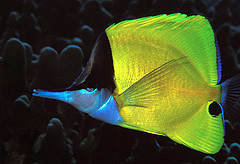Aeration and circulation goes hand in hand. Adding oxygen is one thing, but it must be distributed throughout the aquarium.
Aeration, pronounced as “air-AY-tion,” is the process in which you add oxygen to the water. Fish and invertebrates need oxygen to survive.
This is really just when you add air to the water. But when you do, oxygen diffuses into the water.
Circulation is very important for reef aquariums. It does not only deliver oxygen but also:
- Sweeps away wastes
- Delivers food
- Helps the animals’ own internal circulation
When the water in the aquarium keeps on moving, you are also evenly distributing the temperature of the water.

Your saltwater aquarium heater is only efficient of there is a good circulation of water in the tank. It’s not good if it only heats one corner of the tank.
Most of the filter systems aerate the water in some way, shape or form.
For example, the undergravel filter with powerheads provides circulation and aeration. Also the input piping of from a canister filter or trickle filters provides some sort of circulation and aeration.
Live rock however doesn’t provide circulation or aeration but provides excellent filtration.
In fact, circulation and aeration is needed to keep live rock healthy and to maximize biological filtration.
What about the size of the bubbles?
The size of the bubbles that comes out of your aeration system also plays an important role. How small or large your bubble on the saltwater aquarium determines the amount of oxygen that gets in the water.
Having smaller bubbles means more oxygens comes in contact with the water and more gets dissolved on the surface of the aquarium. This means that it’s more effective than having larger bubbles.
However, not all types of fish will be a good pair for smaller bubbles.
Return from Aeration and Circulation to Conditioning Tap Water
